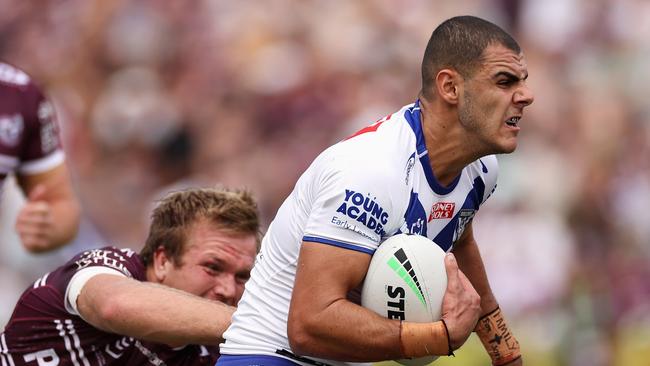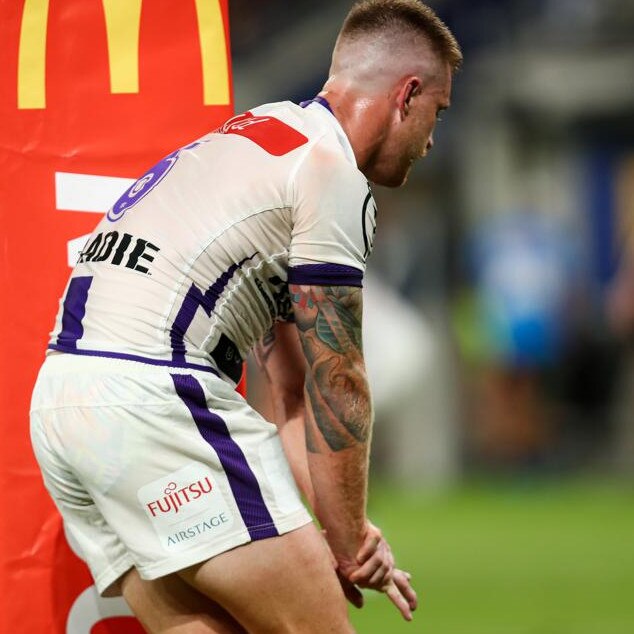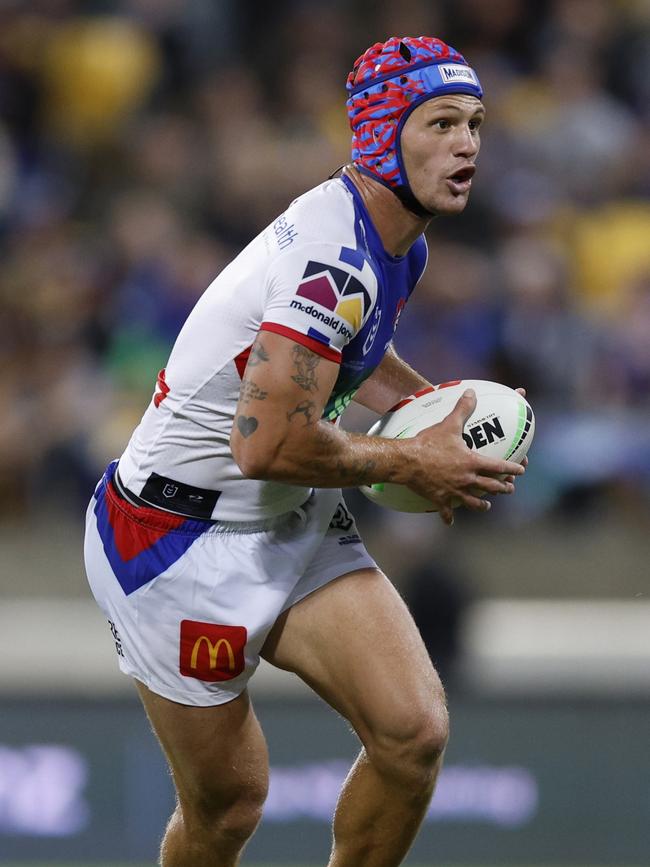Paul Kent: The graphic story behind Cameron Munster’s brave showing against the Eels
Melbourne sent Cameron Munster back out to face the Eels with his finger looking a complete mess. PAUL KENT reveals the incredible inside story of the 14 minutes.

NRL
Don't miss out on the headlines from NRL. Followed categories will be added to My News.
The peculiar sight of a bone sticking out where no bone is supposed to be wasn’t enough to distract Cameron Munster from what had to be done.
For the record, the finger was off to the side and not so much flapping but kind of rubbery.
In front of him, though, the Storm was defending after being set upon by the Eels and the last thing they needed was Munster going down and leaving his team to cover a man short.
So he stayed up and played an extra minute, made a couple of tackles with blood running down his hand, before the Storm was able to get him off and take him to the dressing for what looked to be the end of his night.
The fracture was a nasty one.
Much worse than a dislocation.
The bone snapped and turned sideways to break through the skin, a T-intersection, and the usual practice from there is for the player to wrap it and ice it until a surgeon can operate.
But Melbourne was stuttering against Parramatta and the player they could most not afford to lose was Munster.
Parramatta scored soon after Munster left to make it 6-0 and the best Melbourne’s attack looked without him was that they appeared to be nothing more complex than one up for a settler.

Meanwhile, a lot was happening in the 14 minutes he was off.
At some point the doctor checked the finger and two pain killers were injected into it, then it was strapped with his middle finger acting as a splint, and Munster was sent back out.
Beyond the pain of a fractured finger that has burst through the skin, one of the added risks in a compound fracture is possible infection.
As absurd as it sounds it is often that, as much as the fracture itself, which discourages doctors from letting players return to the field. The skin is open, the injury aflame, and all sorts of nasty foreign bodies can get into the wound.
Yet Melbourne needed Munster out there last Thursday night and so back out he went, the crossover between Munster’s bravery and Melbourne’s ambition.
No doubt Melbourne did what they could to safeguard Munster against infection.
Friday he flew home to Melbourne to be operated on and Saturday was spent watching the races on painkillers, which is the only way they should be watched, if you think about it.
A night earlier, though, Newcastle played the Warriors and trailed 14-12 late in the game when the ball came loose and Kalyn Ponga and Addin Fonua-Blake both went in heavy for it.
Ponga went low and his head collided with Fonua-Blake’s hip.

He flopped out of the tackle and the back of his head hit the ground and he laid there momentarily before rising.
It is hard to know what else the independent doctor was supposed to do.
Countless players have been knocked out in recent seasons after putting their head in the same vicinity Ponga had his, unaware hip bones carry an undefeated record against the skull.
This is where the NRL finds itself, though.
A day after Ponga was removed from the field by the independent doctor Canberra’s Seb Kris was also taken off for a head injury assessment.
Like Newcastle coach Adam O’Brien a day earlier, Canberra coach Ricky Stuart was frustrated.
It revived the argument that club doctors, because they “know the player best” apparently, should be returned to adjudicate on concussions rather than the independent doctors.
It was an argument first raised a century or so ago now when Canterbury’s James Graham got up and did a little two-step before claiming he was not concussed, refusing to reveal there was a circus playing in his head.
Canterbury’s then chief executive Raelene Castle claimed Graham was not concussed, just that he was “clumsy”.
Graham is now one of the game’s great advocates for protecting players against themselves when it comes to concussions.
All this has created an enormous amount of hot air over the weekend, reviving the game’s ability to create something from nothing.

Namely because club doctors are also sideline to assess players.
Of the 19 HIA’s over the weekend, 14 were instigated by the club doctor.
The independent doctor watches from the bunker in Redfern, watching camera angles that can’t be reviewed on the sideline.
That’s how Canterbury’s Jacob Kiraz got picked up against Manly on Saturday.
While it frustrated his coach, Cameron Ciraldo, Kiraz played the ball after a heavy tackle but, on a camera angle that did not air, he began to run back to position and stumbled.
The independent doctor ordered him off.
Some players are too tough for their own good.
Munster returned to the field on Thursday night when many players would not have, a testament to the tough school they foster in Melbourne.
But he was alert enough to contribute to the decision.
A concussed player, despite proclamations he is perfectly healthy, is not.





